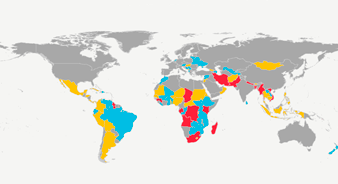Indicator 6.b.1 “Proportion of local administrative units with established and operational policies and procedures for participation of local communities in water and sanitation management”
Target 6.b encourages community participation in water and sanitation management – this page explains why and how to monitor progress towards the target.
The indicator at a glance
Indicator 6.b.1 tracks the level of stakeholder participation in water and sanitation management within a country:
- Participation refers to a mechanism by which individuals and communities can meaningfully contribute to management decisions and directions.
- Local administrative units are institutional units whose authority extends over the smallest geographical areas distinguished for administrative and political purposes within a country.
The indicator currently includes information about the existence of procedures in law or policy for participation by service users and communities, and the level of their participation, disaggregated by sector (drinking water, sanitation, hygiene promotion and water resources planning and management).
Available support
The World Health Organization (WHO) and Organization for Economic Co-operation and Development (OECD) are the custodians of indicator 6.b.1. For any inquiries about available support, please contact their helpdesk.
Guidance on data collection and reporting
- WHO: Monitoring methodology.
- WHO: Country survey documents and instruction modules for GLAAS 2021/2022 cycle.
- UN-Water: Data collection process and timeline.
Online support
- WHO: Helpdesk (email, phone, video conference).
Data and progress reporting
- UN-Water: SDG 6 Data Portal.
- WHO: 6.b.1 data (GLAAS data portal).
- UN-Water: GLAAS 2017 Progress Report.
- UN-Water: GLAAS 2019 Progress Report.
- UN-Water: GLAAS 2022 Progress Report.

Why monitor stakeholder participation?
Data collection stimulates active stakeholder participation, which is essential to ensure accountability and long-term sustainability of water and sanitation solutions.
